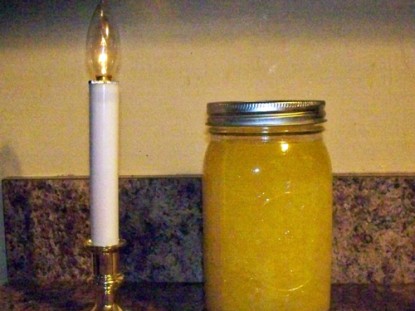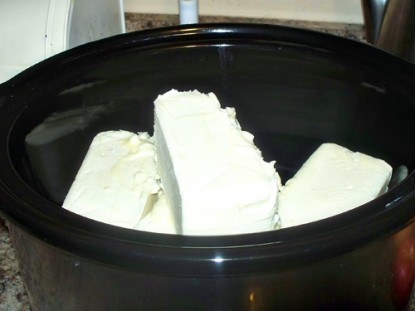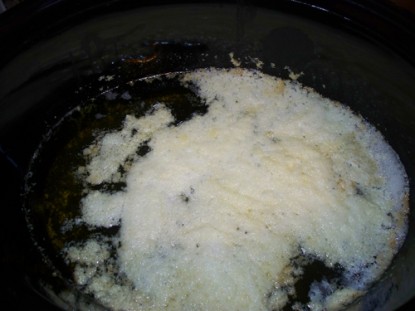I have been curious about a mysterious “something” I keep hearing and reading about among friends and online. Last week, the mysterious subject came up again, when Helen, a CITR friend asked me if I had ever made–ghee!

She explained to me that it is simply clarified butter. The butter is heated slowly and the milk solids separate from the oil. The oil is retained and that is what is called ghee. Because the milk solids are removed, ghee has a high smoke point, making it harder to burn than butter. It keeps extremely well (even unrefrigerated) as long as you keep it out of direct light. (A plus for anyone interested in emergency prepping!) Refrigerating, of course, prolongs its life even more. Many people claim various health benefits from using ghee.
I began reading to learn more about making ghee. As we at CITR found in lard rendering, there are many methods that can be used to make ghee. I chose to use my crock pot.
How to make Ghee in a Crock Pot:
unsalted butter
crock pot
strainer
cheesecloth
jar
Place the unsalted butter in the crock pot. I used 4 pounds.

Set the crock pot on low and let it go for several hours. I had read that is it important to keep the pot on low, as a higher temperature could burn it or give it a bitter taste, rather than the slightly nutty, buttery taste. I checked the pot periodically, and watched as foam appeared on top of the melted butter.

After a while, the foam disappeared and then reappeared, turning a light golden brown. At this point, the oil separated from the solids and can be poured through a fine strainer or cheese cloth into a sterilized glass jar. As the ghee cools, it thickens but remains quite soft with a somewhat grainy texture. From 4 pounds of unsalted butter, I made 2 quarts of ghee.
Get the handy print page and save this to your recipe box here:
Ghee in a Crock Pot.
In doing further reading (and some personal research), I find that ghee can often be used in baking–especially recipes calling for oil. It can be chilled and used in pie crust with ice water as a binder. It is great for popping corn in. I sautéed onions and green peppers with ghee last night–fabulous! Pancakes this morning were wonderful. French style omelets, cooked in ghee, will not turn brown as there are no milk solids to overcook! In the past, the only way to avoid the browning of the eggs would have been through using oil–yuck. Also, when sautéing, much less ghee is needed as opposed to oil.
Since the water in the butter is cooked out of the ghee, it will keep longer. It may not be a good idea to go back and forth from fridge to cupboard, as condensation could form and spoiling might be possible. Leaving your ghee on the counter, out of direct light and used within a few weeks (many say longer) should not be an issue. If I were rarely using it, I would probably keep it in the refrigerator. I have a feeling I will be using mine often!
Pure Indian Foods has a nice article which compiles a lot of information about what ghee is, its nutritional value and its many, many uses.
Do you have a recipe post or kitchen-related story to share on the Farm Bell blog?
Read information here for Farm Bell blog submissions.
Want to subscribe to the Farm Bell blog? Go here.



LauraP says:
What a great summary! And it really is that easy. The most difficult part for me is letting go of the butter-love — ghee’s a better choice so much of the time but we’re addicted to the taste of butter.
On January 7, 2011 at 7:16 am
Laura says:
Great job Cat!!!!
On January 7, 2011 at 7:37 am
glenda says:
I am like Laura, I would hate to melt that much butter….I don’t have that much butter. Of course, if I would milk daily, I could have that much butter…………What a dilemma.
Glad to read this; I wasn’t sure what ghee was. So, basically clarified butter.
On January 7, 2011 at 7:38 am
Cathy Jones (catray44) says:
I really did not lose that much from the butter- two qt.s of Ghee is quite a bit. The Ghee tastes great- kind of a nutty, buttery taste. Many people save the milk solids, which probably amount to a few tablespoons, for eating on toast or bread, etc.
On January 7, 2011 at 7:51 am
Yankee Gal says:
And the best part of Ghee is it’s a safe food for those of us who are lactose intolerant. (Warning: but NOT safe for those with a milk allergy) I’ve never attempted the crock pot method but will give it a try this weekend. Looks much easier! Thanks Cat.
On January 7, 2011 at 9:36 am
CindyP says:
Thank, Cathy!
I wouldn’t think of it as taking away from your butter but adding to the things that would be better cooked in this rather than burnt butter!
I’m going to give this a try!
On January 7, 2011 at 10:35 am
Jessica says:
My husband makes ghee for dipping crab and lobster. He just uses one stick of butter because we hadn’t thought to use it for other things.
On January 7, 2011 at 2:08 pm
Helen says:
Great blog post, Cat, and well-done on the ghee-making, too 🙂
On January 7, 2011 at 4:29 pm